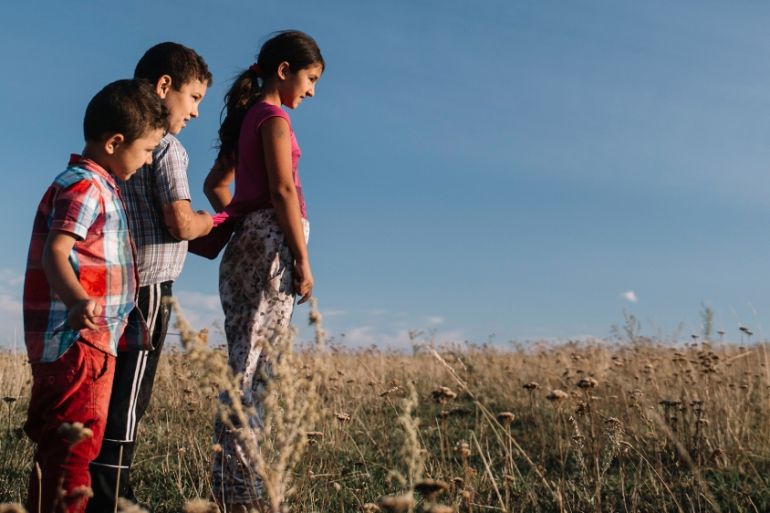
The Dry Valley: Hopes and Dreams in a Romanian Village
A portrait of a Romanian village where many of the Roma residents must leave for Scandinavia to make a living.
Editor’s note: This film is no longer available to view online.
“All of this here – the road, the field, this whole village – everything is Valea Seaca,” says Manuel, a young Roma boy, of his village in northern Romania.
Keep reading
list of 4 itemsDenmark’s tough laws on begging hit Roma women with few other options
Another Roma boy dies in police chase, marking grim pattern in Greece
‘My father didn’t beat my mother in a gypsy fashion-he just beat her’
He is standing on a hill, looking out over a cluster of trees and houses nestled in a gently sloping valley.
Life in the village is simple: neighbours chat, children play in a straw-coloured field and women collect laundry from clotheslines.
But it is also a struggle, as the Roma of Valea Seaca encounter discrimination in the education system and job market.
Many, like Manuel’s father, leave, travelling across Europe to Scandinavia, where they find informal work or beg in order to send money home to their families.
As parents work for a better life for their families, their children dream about their futures; a young girl named Bianca hopes to be a police officer, while her brother wants to have a job and own a car.
A man named Gelu explains why Roma people face an uphill battle: “Our history in Romania starts with slavery. We don’t know what was before that. Just like animals, tied up by the throat with chains.”
“Roma people,” he says, “adapt to any circumstance. To the best and worst alike, to anything.”
____________________________________________________________________________________
FILMMAKER’S VIEW
By Julie Lunde Lillesaeter and Julia Dahr
In the last decade, Norway has become a temporary home to many Roma, who have come from Romania and neighbouring countries in search of new opportunities. While some find work, many end up on the street where they collect bottles, play music or beg for change.
For well-to-do Norwegians who are not used to seeing poverty up-close, this has led to some uneasiness. Most people never interact with these street workers, apart from perhaps giving a coin or two. Therefore, perception of Roma migrants in Norway – as well as in many other European countries – is, to a large extent, defined by media narratives.
Unfortunately, these narratives have tended to be relatively one-sided and often allude to organised crime. The main concern seems to be how their presence affects Norwegian cities, rather than why people come in the first place.
As a result, most Norwegians know little about the complex history and culture of Europe’s Roma population. The group has endured centuries of slavery, Nazi persecution during the Holocaust, and systemic discrimination, which ensures that the Roma remain one of Europe’s most disadvantaged minority groups.
It is not surprising, then, that a 2015 survey showed that Roma was the minority group that Norwegians, and northern Europeans in general, had the most negative impression of. And this can lead to dangerous consequences: anti-Roma sentiments, policies and hate crimes have become increasingly commonplace in Europe.
As filmmakers, we felt that we were missing parts of the story. Who are the people who leave their homes? What brings them to Scandinavia, and what are their hopes and dreams for the future? How do their ties to Scandinavia shape the places they are leaving behind? These questions marked the beginning of a journey that took us to Valea Seaca – “the dry valley”.
This small town in northern Romania has also been called ‘Romania’s Scandinavian village,’ and it was not hard to understand why. Most of the Roma villagers in Valea Seaca had spent time in Scandinavia or had family members who had been. Everywhere we went, people greeted us with a Scandinavian “hei.” Children wore T-shirts with Norwegian logos, and we were served coffee brought back from Sweden, in houses being improved, little by little, from earnings made in Scandinavia.
Walking around in Valea Seaca with our camera, we were at first met with scepticism and sometimes even hostility from people who had negative experiences with the news media. But after a few days, we started to get to know people and experienced their incredible generosity. They welcomed us into their homes, shared meals with us and introduced us to their friends and relatives.
We wanted to make a film that helps viewers to understand Roma migration by hearing from people who are often spoken about, but rarely get a chance to have their voices heard. In our film, you will meet young men frustrated by Romania’s lack of job opportunities, a Roma social worker providing care for children with parents abroad and a young mother who wants a different future for her daughters.
But just like any other media portrayal, our film, too, is formed by our backgrounds and world views. We do not know what it is like to live in poverty, but we are the ones making the film, not the villagers. The Dry Valley should not be taken as an objective depiction, or as an attempt to tell the “whole story”. Instead, it is a portrayal of a specific place at a particular time. Our hope is that it will offer viewers a different perspective, and help shift the focus of media narratives, even if just by an inch.